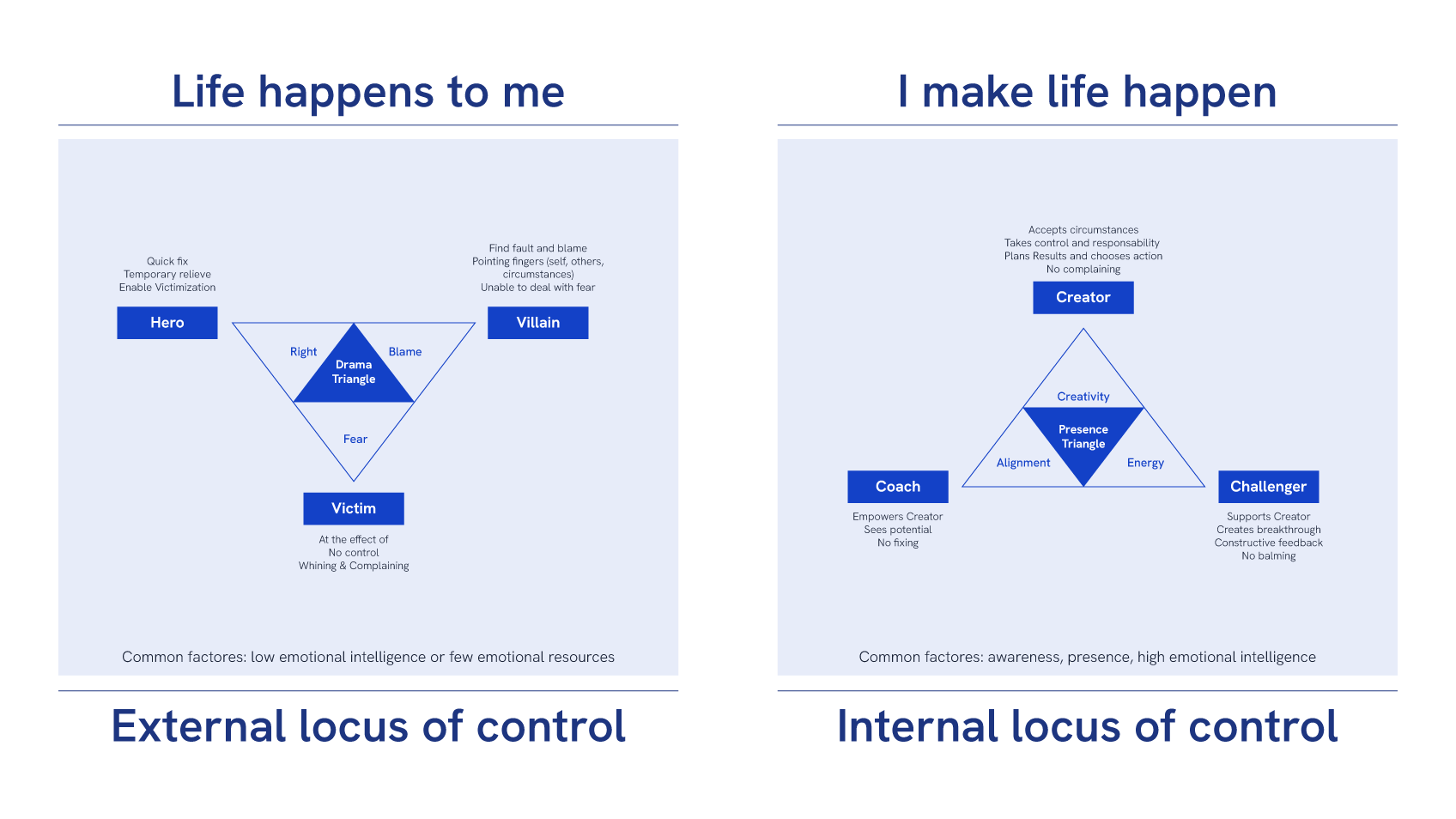09-04-2024
Conscious Leadership: understanding and escaping the Drama Triangle
by Catarina Menino, Talent Engagement Specialist
In the realm of Leadership and personal development, the concept of conscious Leadership has emerged as a transformative approach, empowering individuals to lead with awareness, purpose, and integrity.
At the heart of conscious Leadership is the recognition of specific dysfunctional patterns that undermine our ability to lead effectively and live fulfilling lives. If you’ve ever found yourself trapped in a personal Drama Triangle, you already know how you look at problems or situations with a pre-determined perspective that can be useful or not.
One such pattern is encapsulated in the Drama Triangle, a model of social interaction introduced by Stephen Karpman in the 1960s. Understanding this model is crucial for anyone seeking to cultivate a conscious leadership style and create a positive impact in their personal and professional lives.
The Drama Triangle
When problems or situations arise, the Drama Triangle outlines one of three roles that people often adopt, subconsciously and aligned to their interests and personalities: the Hero, the Villain, and the Victim.
Each role represents a common yet ineffective response to conflict, creating a cycle of blame, wanting to be correct, toxic fear and adrenaline, like dramas in the movies, with characters that play specific roles. The Hero is a quick fixer, seeking temporary relief and enabling victimization. The Villain (master in blame and pointing fingers at self, others or circumstances) cannot deal with fear healthily. And the Victim, whining and complaining that life is happening to them, feels powerless and at the effect. These roles are not static; individuals can shift from one to another, perpetuating a cycle of conflict and misunderstanding. For instance, a hero might become a villain when their efforts to help are rejected, or a victim might become a villain when they lash out in frustration. The same person can also play multiple roles in one situation.
The questions are: how do we move out of these unhelpful roles? How do we break free from the Drama Triangle?
Escaping the Drama Triangle requires a shift towards self-awareness and conscious Leadership. It begins with recognizing and accepting one’s role in perpetuating these dynamics. Think about the magic in transforming the Drama Triangle into an Empowerment and Conscious Triangle. Where, instead of everyone trying to prove that they are the most prominent victim, the roles change?
So, in the Conscious Triangle, the Victim moves to be a Creator (takes control and responsibility and stops complaining about what is happening to them), and the Villain becomes the Challenger (bringing healthy pressure to the Creators to support them, facing, dealing and creating breakthrough). The Hero becomes the Coach (sees everyone as fully empowered Creators and seeks to help them take responsibility for shaping the life they most want).
The Conscious Triangle introduces healthy scripts inviting characters to embrace a positive dynamic. It offers a more positive framework for interpersonal dynamics, emphasizing growth and self-responsibility, and you’ll find yourself and the ones around you more creative, engaged, aligned, energized and get more things done! Here are some strategies to transcend the Drama Triangle:
Self-Awareness: regularly reflect on your interactions and identify any tendencies to adopt one of the Drama Triangle roles. Awareness is the first step towards change.
Responsibility: take ownership of your actions and feelings. Instead of blaming others or external circumstances, focus on what you can control and how to respond constructively.
Empowerment: encourage self-reliance and empowerment in others. Instead of rescuing, support others in finding solutions and developing their capabilities.
Open Communication: foster an open, honest, and compassionate environment. Address conflicts directly and constructively, focusing on solutions rather than blame.
Mindfulness and Presence: Cultivate mindfulness practice to stay present in the moment. This can help you avoid reactive patterns and respond with clarity and compassion.

So… It Begins with You
The journey toward conscious Leadership and escaping the Drama Triangle starts with a profound yet simple realization: it begins with yourself. By understanding the roles within the Drama Triangle and choosing to step out of these limiting patterns, you can transform your leadership style and life.
In doing so, you solve your life’s challenges more effectively and inspire those around you to do the same, creating a ripple effect of positive change.































